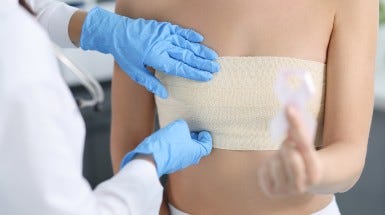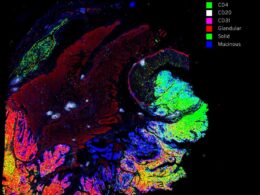A magnetic marker liquid injected into people with invasive breast cancer will help surgeons discover if the cancer has spread, after the technology was recommended in draft NICE guidance.
NICE UK
17 May 2022
Surgeons working in hospitals with limited or no access to a radiopharmacy department could now use Magtrace and Sentimag as an option to locate sentinel lymph nodes in people with breast cancer.
The recommendation in draft NICE medical technology guidance could see a change in NHS standard care for the first time in years.
The technology could also mitigate the reliance on radioactive isotope tracers shipped in from outside Great Britain.
Surgeons working in hospitals with limited or no access to a radiopharmacy department could now use Magtrace and Sentimag as an option to locate sentinel lymph nodes in people with breast cancer.
The magnetic liquid tracer — Magtrace — is a non-radioactive dark brown liquid. It is both a magnetic marker and a visual dye.
The Magtrace is injected into the tissue around a tumour.
The particles are then absorbed into the lymphatic system, following the route that cancer cells are most likely to take when they spread from the primary tumour and become trapped in sentinel lymph nodes.
The Sentimag probe moves over the skin emitting sounds of different pitches as it passes over the Magtrace tracer, in a similar way to a metal detector locating metal in the ground.
The nodes often appear dark brown or black in colour, which also helps with identification.

Once the sentinel lymph node is located, the surgeon makes a small incision (about 1/2 inch) in the overlying skin and removes the node for biopsy.
The sentinel node is then checked for the presence of cancer cells by a pathologist.
If cancer is found, the surgeon may remove additional lymph nodes, either during the same biopsy procedure or during a follow-up surgical procedure.
The procedure may be done on an outpatient basis or may require a short stay in the hospital.
Breast cancer is the most common cancer in the UK with approximately 54,000 new cases of invasive disease annually.
Most breast cancers occur in women, but around 300 men in the UK are also diagnosed with invasive breast cancer each year.
Evidence presented to NICE’s independent medical technologies advisory committee showed that Magtrace and Sentimag is likely to be as effective at detecting sentinel lymph nodes as the current standard practice.
Evidence presented to NICE’s independent medical technologies advisory committee showed that Magtrace and Sentimag is likely to be as effective at detecting sentinel lymph nodes as the current standard practice.
The current standard practice requires nuclear medicine safety procedures and facilities because it uses a radioactive isotope tracer and a blue dye dual technique.
Currently people having a procedure using the radioactive isotope tracer and blue dye dual technique may have to travel to a different hospital with a radiopharmacy department to have the radioactive isotope injected, usually the day before surgery.
The blue dye is then injected once the patient is anaesthetised in the operating theatre.
However, Magtrace is not a radioactive substance, and it does not require the use of blue dye which is associated with a risk of anaphylaxis.
However, Magtrace is not a radioactive substance, and it does not require the use of blue dye which is associated with a risk of anaphylaxis.
The Magtrace technology may allow NHS sites carrying out the procedure to benefit from improved efficiency in the use of their operating theatres…
… because they do not have to rely on a daily supply of radioactive isotope or availability of nuclear medicine staff.
Also, Magtrace can be injected 20 minutes before a biopsy, or up to 30 days before surgery.
This is likely to mean people can be injected at a pre-operation appointment.
Each year 28,600 people to undergo a sentinel lymph node biopsy.
Jeanette Kusel, acting director for MedTech and digital at NICE, said:
“People with breast cancer want to know if their cancer has been isolated or has spread to the rest of their body. The earlier this is established, the better the potential outcomes will be.
“Using the Magtrace technology is another option for surgeons who work in hospitals with limited or no access to radiopharmacy departments. The benefits of using this technology include the potential for more procedures to take place, reducing the reliance on radioactive isotopes shipped into the country and for less travel for people having a biopsy.
“This is a great example of NICE driving innovation into the hands of professionals to improve care.”
Magtrace costs £226 per unit (excluding VAT). The Sentimag probe costs £24,900 to purchase.
Magtrace costs £226 per unit (excluding VAT). The Sentimag probe costs £24,900 to purchase.
Clinical expert advice heard by the committee suggested that hospitals with limited or no access to a radiopharmacy department are more likely to benefit from using the technology as they may be able to do more sentinel lymph node biopsy procedures and see improvements in theatre scheduling.
Magtrace and Sentimag could also be an option for some hospitals with onsite radiopharmacy departments, who still have challenges with theatre scheduling or experience delays.
Magtrace and Sentimag could also be an option for some hospitals with onsite radiopharmacy departments, who still have challenges with theatre scheduling or experience delays.
NICE has requested data is collected to understand if cost savings are made once the technology is adopted.
The committee was advised that there are some side effects and adverse events associated with the technology.
- These include skin staining
- and future MRIs can be affected after using Magtrace, — so use of Magtrace should be considered carefully for people who are likely to need follow-up MRI studies.
The draft guidance is now open to public consultation via nice.org.uk until Thursday 16 thJune 2022.
Originally published at https://www.nice.org.uk on May 17, 2022.
Names mentioned
Jeanette Kusel, acting director for MedTech and digital at NICE












